Are there cultural differences, in how Mississauga and Toronto go about dealing with land use planning processes?
I’ve written in the past about cultural differences between Mississauga and Toronto.
The differences – as I had seen them – were based on things I had anecdotally observed, by way of public meetings and land use planning processes in the two cities up until 2018, at which point we moved from Toronto to Stratford where we now live.
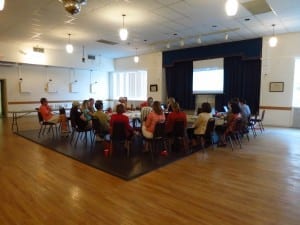
Around 20 people attended an August 21, 2013 meeting as part of the Lakeview Waterfront Connection Environmental Assessment process, at the Long Branch Legion Branch. In my anecdotal experience, such meetings connected with the Lakeview project entail productive civic engagement in land use decision making. Jaan Pill photo
The purpose of the current post is to review the conclusions I had arrived at in 2018, regarding how Mississauga and Toronto went about making land use decisions.
In 2018, I believed that there was indeed a difference in how Mississauga and Toronto were going about making such decisions.
In 2022, I look forward to seeing how Mississauga addresses opposition by residents to tall towers along the Mississauga waterfront.
How the matter is addressed will determine whether or not there are, indeed, cultural differences in how the two cities go about dealing with land use planning processes.
The current post also shares some background – now part of local history in Toronto – about the Long Branch Character Guidelines based on information shared at an April 4, 2018 public meeting in Long Branch.
I sometimes think about this meeting, because at the start of it two City staffers told me something I had never heard before, and have never heard since. I was told that I was not permitted to electronically record the meeting or to directly quote what was said in the event I wrote down direct quotes in my notebook. I subsequently learned that there was no basis for such a prohibition. I’m still scratching my head with regard to this episode.
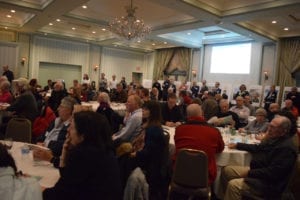
Nov. 21, 2017 Port Credit community meeting concerned redevelopment of former Imperial Oil Lands at 70 Mississauga Road South. Jaan Pill photo
How tall is too tall?
A Nov. 21, 2017 post is entitled: The Mississauga meme has been: “No Tall Towers on the Lake” – will the meme survive?
The post describes a well-attended public meeting, featuring many lively discussions, held at the Waterside Inn in Port Credit on Nov. 21, 2017.
The meeting was concerned with redevelopment of the former Imperial Oil Lands at 70 Mississauga Road South. West Village Partners, the new owners of 70 Mississauga Road South, had at that point prepared a draft master plan for the site.
Port Credit Inspiration had previously hosted a community meeting on June 8, 2017 where West Village Partners presented a version of a draft master plan.
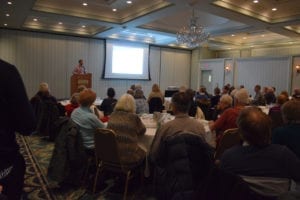
Nov. 21, 2017 Port Credit community meeting concerned with development of former Imperial Oil Lands at 70 Mississauga Road South. Jaan Pill photo
I attended the above-noted meeting, as well as the subsequent community meeting that was held, regarding a draft master plan, on Nov. 21, 2017.
I was very impressed with the large turnout, at both the June 8 and Nov. 21, 2017 meetings. The level of involvement, by the local Port Credit community, has been most impressive.
I also had the sense that in the ongoing community consultation as it relates to Inspiration Port Credit and Inspiration Lakeview, the alignment between rhetoric and reality, with regard to community consultation, was very close. That stands in contrast to other communities where, in my experience, rhetoric and reality are at times very far apart, at the end of the day when outcomes can be assessed.
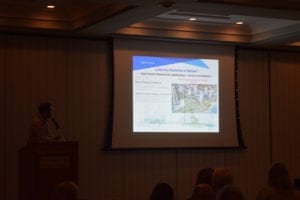
Nov. 21, 2017 Port Credit community meeting concerned with development of former Imperial Oil Lands at 70 Mississauga Road South. The image at the bottom of the slide shows a cluster of tall buildings next to the shoreline of Lake Ontario. Jaan Pill photo
It also has occurred to me, at that time, that much of life, including political life, involves memes.
A standard meme in Mississauga, which I have shared at previous posts, is that politicians such as Ward 1 Councillor Jim Tovey and former mayor Hazel McCallion had remarked in the past that it’s characteristic of Toronto that you see a wall of tall condos facing Lake Ontario.
The corollary is that, in Mississauga, there have been no tall towers on the Mississauga waterfront – and there had been no plans to so place them, in the future.
The meme, as I understand, was in the past a point of pride among many residents of Mississauga.
As it happened, however, the June 8, 2017 meeting included a proposal to situate at least one tall condo at the waterfront. That detail caught my attention.
I wondered, “How will the previous, great meme be retired from service? What alternative meme will be launched, in order to differentiate the City of Mississauga from the City of Toronto?”
At the Nov. 21, 2017 meeting, one of the slides showed what the community consultations, in the prior years of community meetings, had arrived at, with regard to the proposed built form for the former former Imperial Oil Lands at 70 Mississauga Road South.
What you saw in the original concept was a cluster of medium-rise buildings located in the central area of a stretch of land extending from Lake Ontario to Lakeshore Road West. By the water, what you saw was a few slightly taller – but not overwhelmingly tall – buildings.
The concept presented by West Village Partners on Nov. 21, 2017, in contrast, had low-rise buildings in the centre of the stretch of land and a grouping of high-rise buildings (with one building at 26 storeys) very close to the lake.
A key point that I recall from the meeting is that one resident spoke of his discussion table’s dislike of the high towers in the proposal, as well as their proximity to the lake, and to the big move away from the original plan.
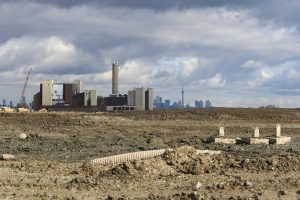
Image from Jan. 3, 3022 Toronto Star article entitled: “How high is too high? Mississauga residents and developers in tug-of-war over buildings heights along waterfront.” Caption reads: The CN Tower is seen in the distance from the site of the future Lakeview Village, a massive, billion-dollar mixed-use development in Mississauga set for the 177-acre site of former coal-fired stacks
Jan. 3, 2022 Toronto Star article
We move on to a Jan. 3, 2022 Toronto Star article entitled: “How high is too high? Mississauga residents and developers in tug-of-war over buildings heights along waterfront: ‘We want people enjoying the waterfront without feeling they are being toppled over by tall buildings,’ says one community leader.”
I’ve accessed this article at the Toronto Public Library website. It took me a while to find it online.
This is a fascinating article; the following excerpts provider some highlights from it:
The project calls for the conversion of 177 acres of industrial land into a dynamic neighbourhood that would in the future be home to as many as 20,000 new residents.
There have been local tensions over the proposed heights of the buildings — conflict between residents who live nearby and the team of developers behind the proposal, including TACC Construction, the Greenpark Group, CCI Development Group of Companies, Branthaven and Argo Development Corp., an umbrella group in the GTA operating under the name Lakeview Community Partners Limited.
The partnership purchased the site in 2018 — after consultations pertaining to the land had been well underway between the City of Mississauga and local residents.
Community members want the development to be comprised of midrise buildings — and no tall towers at the water’s edge.
“During all the community consultations, 16 years of it, the one solid thing residents have been saying is because of the Humber Bay Shores that people can see in the distance, we don’t want (our waterfront) to look like that,” Deborah Goss, president of the Lakeview Ratepayers Association, says in an interview.
“We want people enjoying the waterfront without feeling they are being toppled over by tall buildings,” Goss later adds.
So far, a planned 24-storey building near the waterfront has become a major sticking point for the community. Residents want the height reduced by half.
Differences in how things are done in Mississauga as compared to Toronto: 2018 post regarding Long Branch Character Guidelines
A previous post is entitled:
Cultural differences between Toronto and Mississauga are evident at land use planning meetings
On April 4, 2018, as the post notes, I attended a meeting organized by the Long Branch Neighbourhood Association.
The key topic of the meeting, which took place at the Royal Canadian Legion Branch 101 near the Long Branch GO station, concerned the question of how the Long Branch Neighbourhood Character Guidelines might affect future land use planning decisions in Long Branch.

West beach at Marie Curtis Park, which is located south of the Long Branch GO station on the Lake Ontario shoreline, April 4, 2018. Jaan Pill photo
For a separate series of posts, I have been posting transcripts from a YouTube video of the Nov. 14, 2017 Etobicoke York Community Council meeting, at which the Guidelines were unanimously adopted.
A good reference, regarding the key topic of the April 4, 2018 meeting, is a document entitled:
Long Branch Neighbourhood Character Guidelines – Final Report
As well, the full-length Character Guidelines document can be accessed here. Please note the link in the previous sentence will take some time to load.
No direct quotations from Toronto City staff
In my report on the April 4, 2018 LBNA meeting, which follows below, I have avoided direct quotations of what was said by the three City staff at the meeting.
Instead, my version (below) of the Q & A, involving City staff, is based on paraphrases of what was actually said.
When I report on public meetings, I often record them, to ensure that my quotations are accurate, as is standard journalistic practice.
With regard to the April 4, 2018 Q & A, I was not permitted to make a recording, in either audio or video format.
The protocol, as a City staff person explained to me, is that a person must first get permission from the City, before remarks by City staff at a public meeting can be recorded.
I was also informed, by a City staff person, that I was not permitted to post any direct quotations of what staff said, based on my notes, without first getting permission from the City of Toronto.
I did not record the Q & A, and no direct quotations are included in the text that follows. As well, the names of the City staff at the meeting are not included in this post, given that I am not – as I understood at the time – in a position to directly quote them.
Comment regarding: “No permission to record”
At the April 4, 2018 meeting organized by the Long Branch Neighbourhood Association, two City staffers said I was not permitted to record what City officials said at the meeting, nor was I permitted to post any direct quotations of what staff said at the event, based on my notes, without first getting permission from media relations at the City of Toronto.
After the meeting, I contacted media relations and asked if the above-noted prohibition was, in fact, City of Toronto policy. Among other things, I asked: “Does a person need to get permission from the city before remarks by city staff at a public meeting can be recorded?”
The answer was: “No. Information provided by city staff to the public at a public meeting is a matter of public record. As a courtesy, you may want to advise staff that you are present as a blogger or member of the media but that is not a requirement.”
The bottom line is: If a person is in doubt about a statement, by any person regarding any topic, it’s a great idea to seek verification of it.
At the current post, I paraphrase what was said at the April 4, 2018 meeting given that I did not record the discussion.
[End of comment]
Positive role of Planning staff
It warrants underlining that the Planning Department played a much appreciated lead role, as noted in a transcript of remarks by Councillor Mark Grimes at a Nov. 14, 2017 meeting of the Etobicoke York Community Council, in development of the Character Guidelines.
Whatever protocols are in place, regarding a meeting that I’m writing about, I follow. Most of the time, I am free to record at will; the current circumstance is an exception, as I have noted at a recent post.
With regard to the April 4, 2018 meeting, it was great to have the opportunity, in this case, to cover a meeting entirely using pen and paper. We can, as many people have noted over the years, think of pen and paper, audio and video recording equipment, and the internet, as being extensions of the mind.
When a person puts digital recording equipment aside, as I did on April 4, 2018, the mind (with one less extension to deal with) tends to function in a way that may not happen when the digital equipment has been switched on.
By way of example, when my recorder is turned off, I may at times be more acutely attuned to the atmosphere – the feeling in the air – in a roomful of people at a meeting, than I would be if I know I am recording the event.
The version of the Q & A, that you are reading at this post, is is a re-enactment, using paraphrases in place of direct quotations, of what was said at the April 4, 2018 meeting
The Answers that follow are paraphrases of what City staff said in response to Questions from residents. The Questions that follow are also paraphrases.
What is posted is a re-enactment of what transpired. Words have been disguised and speakers have been granted anonymity, in order to protect the innocent which in this case includes me.
The text, that is to say, of the Q & A expresses – in my own words, not the words of the speakers – the gist of what each person said, as recorded in my notes. Nothing in the text is meant to mirror, word for word, what anybody actually said. Any inadvertent close correspondence, between a paraphrase and what was actually said, would be a totally unintended coincidence.
You are, that is, reading the equivalent of a docudrama as contrasted to a documentary.
Some of the Questions in the following Q & A are compilations based on Questions from several residents. Some Answers, in turn, are compilations based on Answers from more than one staff person.
Words in square brackets – [that is, like this] – represent my own annotations
The Q & A textual docudrama follows:
Q: Why was Long Branch chosen as the neighbourhood, out of all the neighbourhoods in Toronto, as the site for the first-ever Character Guidelines Pilot Project?
A: A Lot-Split Study had been completed by the City. At some point, the thought occurred: Why not set up a Pilot Project in Long Branch, to study lot-splitting as it pertains to a specific neighbourhood? There’s also a Pilot Project underway in Willowdale, where many lot-splits have also occurred, which will take a few more months to complete.
Once that is completed, the plan is to proceed with development of a City-wide Character Guidelines template, which can be applied even in the most arcane of neighbourhoods, including Mimico [which may or may not include Humber Bay Shores, depending on where you believe the eastern boundary of Mimico is located].
Q: What are the Guidelines about? What do they seek to accomplish?
A: The Long Branch Character Guidelines are about the physical character of Long Branch. They seek to prompt decision makers to look closely, first of all, at the details of a given project, for which an application has been submitted to the Committee of Adjustment.
The Guidelines seek, as well, to guide decision makers to look at adjacent properties, the block on which the subject property is located, and the surrounding neighbourhood.
Whether or not such guidance is followed is up to the decision makers. There is, in fact, no requirement that Committee of Adjustment decision makers are guided by anything, aside from their standard operating procedure, which is to rely solely on their subjective judgement, when assessing a given application.
What is predominate?
Q: Consider the situation where one or two houses have been recently built, that residents view as totally out of keeping with the physical character of their neighbourhood. Will the Guidelines then assume that such new buildings are actually representative of the local neighbourhood?
A: What you have to consider, in this case as in others, is: What is predominate? Some new builds [that is, structures], that have approved in the past, fit in well with the physical character of the neighbourhood, and some do not. It can be added that, on occasion, people learn from their mistakes.
Q: So, what is the character of Long Branch?
A: The details are listed on pp. 27-28 of the Long Branch Character Guidelines. However, the character is not solely encompassed by what is outlined, at the above-noted pages. When they look at a specific application, Planning staff will ask, “What is the specific thing, that matters in the application that is before us?”
[Please note: Any words in quotation marks, as in the previous sentence, are a paraphrase and not a direct quotation. In my re-enactment of the Q & A, I have consistently avoided word-for-word quotations of speakers.]
Q: Can you clarify what the Guidelines have to say, with regard to height, massing, and setbacks.
A: If the predominant character on the street is a peaked roof, then Planning staff would encourage maintenance of a peaked roof, in the application under consideration.
Application of Guidelines will depend upon the subjective judgement of the Committee of Adjustment
Q: How will the Guidelines be applied? When will they be applied?
A: Any new application made after Jan. 31, 2018 [which is when Toronto Council unanimously adopted the Long Branch Neighbourhood Character Guidelines] will be reviewed in accordance to the Guidelines.
Whether or not the Guidelines will be applied will depend on the subjective judgement of the Etobicoke York Committee of Adjustment.
How, and whether, the Toronto Local Appeal Body applies the Guidelines is beyond the capacity of City staff to predict.
Q: Is there a Character Guidelines checklist, for applicants for building permits to fill out?
A: Not yet. But we ask, [and this is a paraphrase, not a direct quotation], “Give us a rationale, for your application, and explain to us, how the application meets the Character Guidelines.”
Adherence to the Character Guidelines a request, not a requirement
Q: Is adherence to the Guidelines a requirement, on the part of applicants for building permits?
A: Adherence to the Guidelines is a request. It is not a requirement.
Q: What is the exact process, that the Planning Department will be following, with regard to application of the Guidelines?
A: [My notes omitted the answer. I may have been distracted. However, some of the other answers, in this Q & A, serve as responses to this question.]
Q: Will applicants be required to submit diagrams, of the proposed house or houses, as the house or houses will appear when construction is completed? Will applicants be required to show what the proposed builds [that is, buildings] will look like in relation to adjacent and nearby houses on the street in question?
A: We would like to see 3D images. But such images are not a requirement.
Q: Can the Guidelines be applied retroactively, to decisions made six months ago?
Q: No.
Q: If the OMB has approved an application, can that be undone, retroactively?
A: No. What’s done is done. The construction is likely underway or completed by now.
Q: Will the Committee of Adjustment take the Guidelines into account when making future decisions on applications?
A: The Committee has received copies of the Guidelines. The members will look at the document, in the same way they look at anything else. From that point, they make [what the speaker describes as] the best-informed decision.
[The following Question is a compilation of a series of separate Questions, submitted by residents.]
How will the Toronto Local Appeal Body deal with the Guidelines?
Q: How will the Committee of Adjustment know that the Guidelines apply to a given application? How will the Toronto Appeal Body deal with the Guidelines? Will evidence from Planners, related to the Guidelines, be incorporated into the decisions? How much actual influence will the Guidelines have, on the Committee of Adjustment and the Toronto Local Appeal Body? Are minor concessions to the Guidelines all that the decision makers are looking for?
A: If the Guidelines are not addressed, in a given application, the Planning staff will ask for them. At the next stage after that, the application will be reviewed, and a report will be forwarded to the Committee of Adjustment.
If the Committee of Adjustment refuses the application, and it is appealed, then the Toronto Local Appeal Body will receive the same Planning report, as was submitted to the Committee of Adjustment. As well, the same staff, who wrote the Planning report, will serve as expert witnesses at the TLAB.
Will lot severances stop?
Q: Will lot severances stop? How soon will there be fewer lot-splits?
A: We can’t refuse to take applications.
Q: What of undersized, legal non-conforming lots, that date back from an early era in the development of Long Branch?
A: Any lot, of whatever size, is subject to the Guidelines. And, whether it’s a teardown, or an addition, it’s all treated the same.
Q: How will the Guidelines stop soldier houses?
A: Whether it’s called a two-storey or a three-storey, with reference to what is called a soldier house, does not matter. The only thing that matters is the overall height.
Q: How will Planners work with the Guidelines, when an application comes in?
A: A Senior Planner, two Assistant Planners, and a Planner will review the applicant’s rationale, if it exists, which explains how the application adheres to the Guidelines. There is a learning curve involved, with regard to the above-noted review process.
No assigned number, or weight, will be assigned to the Character Guidelines
Q: How will members of the Committee of Adjustment be trained in the Character Guidelines?
A: Each member has a copy of the Guidelines. However, there is no formal training of the members, with regard to the Guidelines.
There is, as well, no defined number, or weight, that will be assigned to the Guidelines, when the Committee makes a decision, regarding an application.
Q: How will Toronto Local Appeal Body members be trained?
A: TLAB can tell you, how TLAB members will be trained.
Q: What does the City look for, when it recommends that a Community Consultation takes place?
A: The idea is to get together, at the same table, in a safe environment. [That is, an environment where participants feel at ease, and maintain a sense of personal safety, including with regard to the tone and nature of verbal interactions.]
From there, a possible outcome may be that a way is found to make the proposal better, from the viewpoint of concerned residents. Or the application may be withdrawn.
On April 23, 2018, there will be a meeting regarding 11 James St.
City Planning staff in future will not request Community Meetings. Residents at a Committee of Adjustment hearing can, however, request that the Committee defer a decision, so that a Community Consultation can be held.
Scheduling of CoA meetings
Q: What if residents, because of their work schedule, are unable to attend a Committee of Adjustment meeting in order to convey the message that an application is not following the Guidelines? What can they do? And what can be done, to ensure that letters from residents to the Committee are given more weight?
A: You can submit a written comment. If you are unable to attend a scheduled meeting, if you want to be sure the Committee members will actually read your submission, it must be submitted at least a week before the meeting.
In that way, it gets included in the package that is sent out a week before the meeting, to Committee members. In that way, they have time to actually read the submission.
Q: How can the Committee arrange its hearings, so that it is more convenient for residents, who have day jobs, to attend?
A: We were previously the only District not starting in the morning. The start time is now 10:00 am. Only brand-new Minor Variances are addressed in the morning. Consent or Deferred applications are not heard in the morning.
Q: How can we get similar Guidelines for Mimico?
A: Once the Willowdale Guidelines are completed, the City will then finalize a City-wide template. Then neighbourhoods elsewhere in the City will get information on how they can get their own Guidelines.
Questions from the floor followed the above-noted, previously submitted written Questions
Q: What is the appeal process? Say there’s a lot-split, where a 50-ft lot becomes two 25-ft lots. It’s refused by the Committee of Adjustment, and the developer goes to the Toronto Local Appeal Body.
A: The Councillor will, in that case, direct City staff to defend the Committee of Adjustment refusal at the Toronto Local Appeal Board.
Q: How many approvals has TLAB overturned?
A: It’s happened often. For example: 38 Thirty Sixth St. was refused by both COA and TLAB. There was a recent case, as well, where a lot-split was approved, but the proposed builds, on the severed lots, were turned down.
Q: The Guidelines lack legal reinforcement. What can be done, to ensure compliance with them? What incentives are in place, to ensure the Guidelines are followed?
A: The zoning regulation is what City staff reviews. Our focus is not with regard to the Committee of Adjustment but the Toronto Local Appeal Body. We recommend that you sit in at a Toronto Local Appeal Body hearing, to get familiar with how it does its work. From the outset, City staff are already thinking about the TLAB hearing.
Our case, with regard to a given application, has to be strong. If a severance is allowed, the aim is to seek a build on each lot, that is less impactful, and less out of character, than the design that was originally submitted.
It may be the case that a severance will get approved. That may be difficult for residents to accept. Some of the resulting builds do fit in. In the case of builds that really stick out in a bad way, it may be good to keep in mind that the originally submitted designs were even more pronounced, in terms of objectionable characteristics.
Q: I’ve heard it said, that the term “Minor Variance” will be reviewed.
A: The term is undefined. Minor Variance does not come with a definition, from the vantage point of the Committee of Adjustment. The chair of the Committee has remarked that it is not possible to place a number on Minor. That is, Minor is more of a subjective term.
Q: In an example the City uses, with regard to Minor, the dimension is with reference to height. A 5 percent variance, in this example, is defined as Minor. We’ve seen the Committee of Adjustment stating that a variance of 250 percent is Minor.
There was a Superior Court decision, based on a legal appeal of an OMB decision. According to that decision, numbers do in fact matter. Does the Superior Court decision matter to the Committee of Adjustment?
A: [My notes are unclear regarding what the first part of the answer was. I start the paraphrase below at a subsequent, later stage of the answer.]
The Committee of Adjustment looks at the project as a whole. It takes into account the cumulative effect, of all of the proposed Variances. It can be the case, that numbers can be misleading. It becomes a form of creativity, applied to mathematics.
Q: The Variances, in the example at hand, exceed the bylaw by 200 percent, or 250 percent. How can, in standard English language usage, a Variance of 250 percent, beyond what the bylaw calls for, be considered Minor?
A: It is not clear what the example, that you refer to, is from.
Q: [The questioner, in response, gives a specific example.] The example, that is referred to, is more than 200 percent. That is mathematics. That is not mathematics that is applied in a creative way.
A: [No comment is offered, regarding the previous Question regarding mathematics, with reference to a specific example.] If, in the minds of the Committee of Adjustment, an application fails on just one, single test, the Committee is obligated to refuse it. The Committee decides. It’s up to the Committee, what the decision is.
Q: There have been two Divisional Court decisions. The Committee of Adjustment should be giving a reason for its decisions.
The Committee of Adjustment is, in fact, usurping the functions of bylaw officials to define what is Minor. As a source of expert opinion at hearings, what is your view, as a City staff person, when you see a footprint that vastly exceeds what the bylaw intensity permits?
A: A difference of opinion may be in place, between me as a Planner and you as a resident, regarding the topics at hand. As well, if you have a concern, you can speak to the Director of the Committee of Adjustment. And, what applies at the City of Toronto applies across the Province of Ontario. Everybody deals with the same state of affairs.
Q: Why is it that the Committee of Adjustment tends to just rubber-stamp pretty well every proposal that entails a lot-split, and resulting overbuilding, on two narrow lots? This kind of thing does not happen in Mississauga. In days gone by, Mayor Hazel McCallion would never allow such things to happen, at the City of Mississauga.
A: You and I have a difference of opinion, regarding what happens in Mississauga, as contrasted to Toronto.
Q: Will the Guidelines apply to the newer applications, that are coming before the Committee of Adjustment?
A: Applications made after Jan. 30, 2018 will be addressed in such a way, that reference is made to the Guidelines.
Q: You spoke earlier of some 12 criteria.
A: The reference was to Section 5124 of the Planning Act.
Please note, by way of repeating a point made at the beginning of this post: What you are reading is a paraphrase, not a transcript, of the Q & A. Nothing in this Q & A is a word-for-word transcript of what was said.
Q: How many times can a builder apply for the same severance?
A: We usually offer the advice that endlessly re-applying may not be the best idea. That said, we cannot refuse an application.
As well, there are cases where a refusal has been based on the build-plan. So the applicant may try again, by submitting a revised plan for the building, that would be built on each of the severed lots.
Q: Who chooses the members of the Committee of Adjustment?
A: Council makes the appointments.
Q: That means who we vote for, by way of choosing our Councillor, is important.
A: The Councillor you choose accounts for one vote at Council. There are 44 other Councillors. Each of them also has a single vote.
Q: Long Branch has a lot of tree canopies. Has the presence of a mature tree ever stopped an application?
A: Urban Forestry does make comments. If they don’t agree with the application, the matter goes to Council [which Council, whether Community Council or City Council, is unclear from my notes].
Sometimes it may happen that an application is deferred, because of the presence of a mature tree. City staff can ask the applicant what it would take, to save the tree, As well, Toronto Forestry staff have, on occasion, attended TLAB hearings.
[End of Q & A, based on paraphrase of what was said]
Oct. 11, 2017 Lakeview Ratepayers Association AGM
By way of illustration of recording practices at the City of Mississauga, among many other public meetings that I have attended in Mississauga over the past decade, I attended the Oct. 11, 2017 AGM of the Lakeview Ratepayers Association.

Mayor Bonnie Crombie speaks at AGM of Lakeview Ratepayers Association, Oct. 11, 2017. Jaan Pill photo
Among the speakers at the latter meeting were Ward 1 Councillor Jim Tovey and Major Bonnie Crombie among other City of Mississauga officials. I audio recorded the entire event, and video recorded key segments. Nobody questioned, for a moment, what I was doing there, and asked me if I had permission to record.
I can add that, as a blogger, it’s been clear that Jim Tovey was a strong supporter of my website, from the moment that he first visited the site.

Councillor Jim Tovey speaks at AGM of Lakeview Ratepayers Association, Oct. 11, 2017. Jaan Pill photo
Jim Tovey liked the fact I was writing detailed posts about innovative, community-driven, Mississauga-based projects, such as the Lakeview Waterfront Connection project and equally innovative redevelopment projects in Port Credit.
Land use planning meetings in Toronto and Mississauga
In Toronto, City officials are, perhaps, a little less aware that bloggers can serve beneficial roles in their communities, and can – if so permitted – help to get the story out, regarding great initiatives that may be happening, in local communities located to the east of the Mississauga-Toronto border.
That said, Toronto has a different culture, in relation to attitudes toward citizen engagement, based on a different history, and thus it makes sense that each municipality will approach things in the way that best suits their purposes.
In terms of atmosphere at urban-planning meetings, on occasions such as recent meetings in Port Credit, where developers, residents, municipal officials, and politicians get together, in Mississauga the “feeling in the air” on such occasions is typically good-spirited, with respect for each person’s point of view, and a distinct sense of “We’re in this together.”
The sentiment, most frequently encountered, at such meetings, is: “We know for sure, that we can find a way that will lead to a great design, that in the end will closely reflect the key positions of all of the sides, without exception, in this suitably spirited debate, that we all have the pleasure to be engaged in.”
In Toronto, at least in south Etobicoke, the atmosphere, at meetings concerned with land-use planning issues, at times the atmosphere is positive, as at meetings of the Long Branch Guidelines Advisory Group, which had a series of meetings during development of the Guidelines.
Feeling in the air, when land-use planning is the topic at hand
At other times, as toward the end of the April 4, 2018 Q & A, the “feeling in the air” that “we’re all in this together” tends to be absent. Not infrequently, Toronto residents express anger at such meetings, and not infrequently, City officials deal with the situation by shutting down the discussion.
I have yet to encounter a situation at a similar meeting in Mississauga, where a City official would have shut down a discussion, in response to the fact that residents were not satisfied with the answers they were hearing.
The underlying reality, in the case of the Mississauga land use planning meetings, that I have attended over a period of close to a decade, is that officials are genuinely interested in the views of residents, and make every effort to ensure their views are closely taken into account. Given this reality, it would be unlikely for a discussion to be terminated, in the way that it regularly occurs, from what I have observed, at similar meetings in Etobicoke.

Leave a Reply
Want to join the discussion?Feel free to contribute!